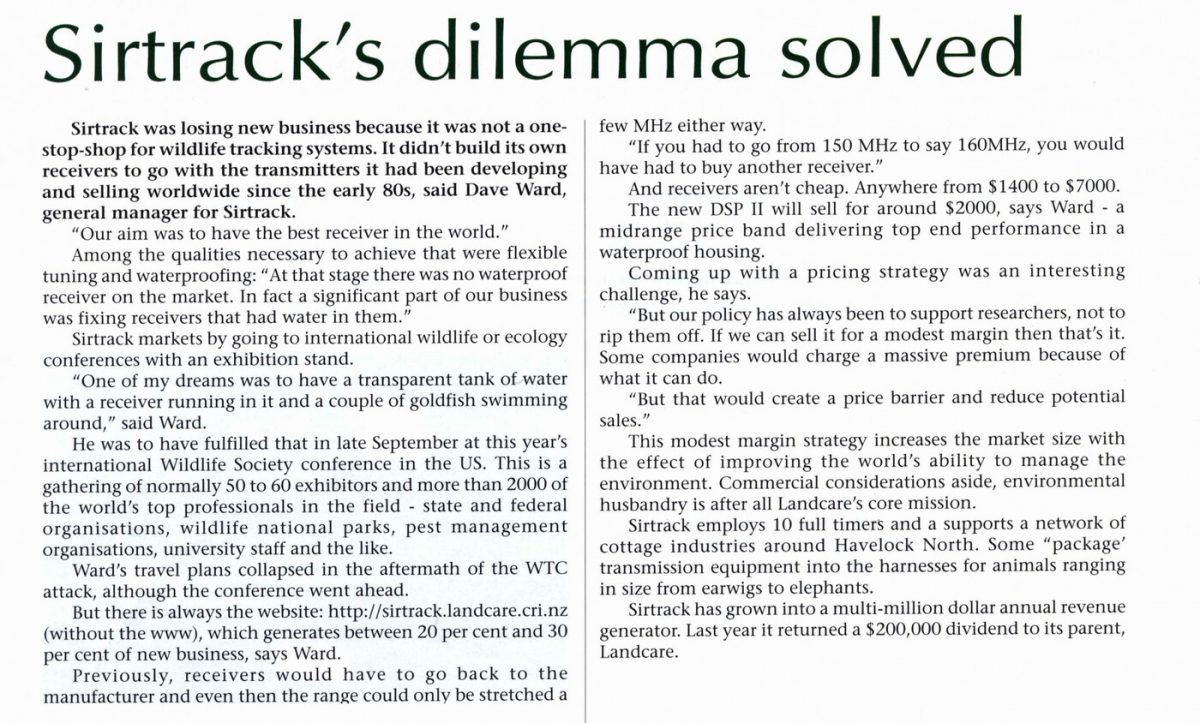Sirtrack’s dilemma solved
Sirtrack was losing new business because it was not a one-stop-shop for wildlife tracking systems. It didn’t build its own receivers to go with the transmitters it had been developing and selling worldwide since the early 80s said Dave Ward, general manager for Sirtrack.
”Our aim was to have the best receiver in the world.”
Among the qualities necessary to achieve that were flexible tuning and waterproofing: “At that stage there was no waterproof receiver on the market. In fact a significant part of our business was fixing receivers that had water in them.”
Sirtrack markets by going to international wildlife or ecology conferences with an exhibition stand.
“One of my dreams was to have a transparent tank of water with a receiver running in it and a couple of goldfish swimming around,” said Ward.
He was to have fulfilled that in late September at this year’s international Wildlife Society conference in the US. This is a gathering of normally 50 to 60 exhibitors and more than 2000 of the world’s top professionals in the field – state and federal organisations, wildlife national parks, pest management organisations, university staff and the like.
Ward’s travel plans collapsed in the aftermath of the WTC attack, although the conference went ahead.
But there is always the website: [http]://sirtrack.landcare.cri.nz (without the www), which generates between 20 per cent and 30 per cent of new business, says Ward. [NB Website address inactive 2016]
Previously, receivers would have to go back to the manufacturer and even then the range could only be stretched a few MHz either way.
“If you had to go from 150 MHz to say 160MHz, you would have had to buy another receiver.”
And receivers aren’t cheap. Anywhere from $1400 to $7000.
The new DSP II will sell for around $2000, says Ward – a midrange price band delivering top end performance in a waterproof housing.
Coming up with a pricing strategy was an interesting challenge, he says.
“But our policy has always been to support researchers, not to rip them off. If we can sell it for a modest margin then that’s it. Some companies would charge a massive premium because of what it can do.
“But that would create a price barrier and reduce potential sales.”
This modest margin strategy increases the market size with the effect of improving the world’s ability to manage the environment. Commercial considerations aside, environmental husbandry is after all Landcare’s core mission.
Sirtrack employs 10 full timers and a supports a network of cottage industries around Havelock North. Some “package” transmission equipment into the harnesses for animals ranging in size from earwigs to elephants.
Sirtrack has grown into a multi-million dollar annual revenue generator. Last year it returned a $200,000 dividend to its parent, Landcare.












Do you know something about this record?
Please note we cannot verify the accuracy of any information posted by the community.